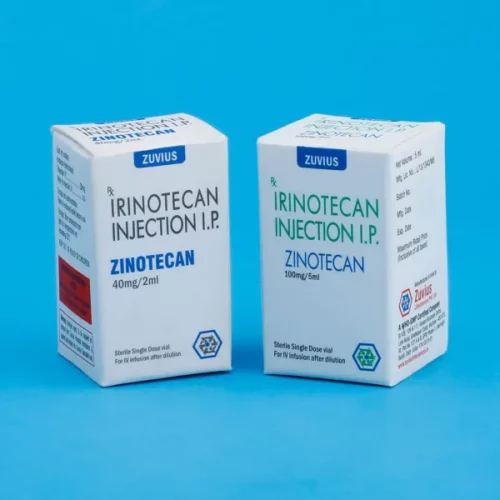Nilotaz Cap-Nilotinib Cap 200 mg
Nilotinib Cap
Strength: 150 mg / 200mg
Pack Size: 1 x 7
Drug Class: Antineoplastics, Tyrosine Kinase Inhibitor.
Dosage and Administration:
Recommended Dosing
Nilotinib should be taken twice daily at approximately 12-hour intervals and must be taken on an empty stomach. No food should be consumed for at least 2 hours before the dose is taken and for at least 1 hour after the dose is taken. Advise patients to swallow the capsules whole with water
For patients who are unable to swallow capsules, the contents of each capsule may be dispersed in 1 teaspoon of applesauce (puréed apple). The mixture should be taken immediately (within 15 minutes) and should not be stored for future use [
Dosage In Adult Patients With Newly Diagnosed Ph+ CML-CP
The recommended dose of Nilotinib Capis 300 mg orally twice daily.
Dosage In Adult Patients With Resistant Or Intolerant Ph+ CML-CP and CML-AP
The recommended dose of Nilotinib Cap is 400 mg orally twice daily.
Dosage In Pediatric Patients With Newly Diagnosed Ph+ CML-CP Or Resistant Or Intolerant Ph+ CML-CP
The recommended dose of Nilotinib Capfor pediatric patients is 230 mg/m² orally twice daily, rounded to the nearest 50 mg dose (to a maximum single dose of 400 mg) (see Table 1). If needed, attain the desired dose by combining different strengths of Nilotinib capsules. Continue treatment as long as clinical benefit is observed or until unacceptable toxicity occurs.
Cold Storage: no
Nilotinib drug substance, in the form of monohydrochloride monohydrate, is a white to slightly yellowish to slightly greenish yellow powder with the molecular formula and weight, respectively, of C28H22F3N7O•HCl • H2O and 584 (corresponding molecular formula and weight of nilotinib base, anhydrous are C28H22F3N7O and 529 respectively). The solubility of nilotinib in aqueous solutions decreases with increasing pH. Nilotinib is not optically active. The pKa1 was determined to be 2.1; pKa2 was estimated to be 5.4.
The chemical name of nilotinib monohydrochloride monohydrate is 4-methyl-N-[3-(4-methyl-1H-imidazol-1-yl)-5-(trifluoromethyl)phenyl]-3-[[4-(3-pyridinyl)-2-pyrimidinyl]amino]-benzamide, monohydrochloride, monohydrate. Its structure is shown below:
 |
Adult And Pediatric Patients With Newly Diagnosed Ph+ CML-CP
Nilotinib Cap (nilotinib) is indicated for the treatment of adult and pediatric patients greater than or equal to 1 year of age with newly diagnosed Philadelphia chromosome positive chronic myeloid leukemia (Ph+ CML) in chronic phase.
Adult Patients With Resistant Or Intolerant Ph+ CML-CP And CML-AP
Nilotinib Cap is indicated for the treatment of adult patients with chronic phase and accelerated phase Philadelphia chromosome positive chronic myelogenous leukemia (Ph+ CML) resistant or intolerant to prior therapy that included imatinib.
Pediatric Patients With Resistant Or Intolerant Ph+ CML-CP
Nilotinib Cap is indicated for the treatment of pediatric patients greater than or equal to 1 year of age with chronic phase Philadelphia chromosome positive chronic myeloid leukemia (Ph+ CML) with resistance or intolerance to prior tyrosine-kinase inhibitor (TKI) therapy.
Usage-:
Nilotinib is used to treat a certain type of blood cancer (chronic myelogenous leukemia-CML). It works by slowing or stopping the growth of cancer cells
Nilotinib is an inhibitor of the BCR-ABL kinase. Nilotinib binds to and stabilizes the inactive conformation of the kinase domain of ABL protein. In vitro, nilotinib inhibited BCR-ABL mediated proliferation of murine leukemic cell lines and human cell lines derived from patients with Ph+ CML. Under the conditions of the assays, nilotinib was able to overcome imatinib resistance resulting from BCR-ABL kinase mutations, in 32 out of 33 mutations tested. Nilotinib inhibited the autophosphorylation of the following kinases at IC50 values as indicated: BCR-ABL (20 to 60 nM), PDGFR (69 nM), c-KIT (210 nM), CSF-1R (125 to 250 nM), and DDR1 (3.7 nM).
Read the label carefully before use
keep out of the reach of children
Myelosuppression
Treatment with Tasigna can cause Grade 3/4 thrombocytopenia, neutropenia and anemia. Perform complete blood counts every 2 weeks for the first 2 months and then monthly thereafter, or as clinically indicated. Myelosuppression was generally reversible and usually managed by withholding Tasigna temporarily or dose reduction
has been shown to prolong cardiac ventricular repolarization as measured by the QT interval on the surface ECG in a concentration-dependent manner
Cardiac And Arterial Vascular Occlusive Events
Cardiovascular events, including arterial vascular occlusive events, were reported in a randomized, clinical trial in newly diagnosed CML patients and observed in the postmarketing reports of patients receiving Tasigna therapy. With a median time on therapy of 60 months in the clinical trial, cardiovascular events, including arterial vascular occlusive events, occurred in 9.3% and 15.2% of patients in the Tasigna 300 and 400 mg twice daily arms, respectively, and in 3.2% in the imatinib arm. These included cases of cardiovascular events including ischemic heart disease-related cardiac events (5.0% and 9.4% in the Tasigna 300 mg and 400 mg twice daily arms respectively, and 2.5% in the imatinib arm), peripheral arterial occlusive disease (3.6% and 2.9% in the Tasigna 300 mg and 400 mg twice daily arms respectively, and 0% in the imatinib arm), and ischemic cerebrovascular events (1.4% and 3.2% in the Tasigna 300 mg and 400 mg twice daily arms respectively, and 0.7% in the imatinib arm). If acute signs or symptoms of cardiovascular events occur, advise patients to seek immediate medical attention. The cardiovascular status of patients should be evaluated and cardiovascular risk factors should be monitored and actively managed during Tasigna therapy according to standard guidelines













